8 de January de 2025
Sport tech and science Velocity Based Training
Best Velocity Based Training Devices – Full Review 2025
Velocity Based Training and VBT Devices
Velocity Based Training (VBT) is a method of training that allows us to know with high precision the relative intensity and degree of fatigue that occurs in each training session.
VBT devices are a tool that provide real-time feedback on Velocity Based Training exercises, enabling coaches and athletes to optimize performance and monitor progress accurately.
With various devices on the market, choosing the right one can be daunting. This guide explores different types of VBT devices, their advantages and disadvantages, notable brands, selection criteria, and scientific validation, providing a complete overview for making informed decisions.
Types of Velocity Based Training Devices
Velocity Based Training devices vary in technology, measurement methods, and application. Understanding these differences helps in selecting the right tool for specific training needs. Let’s see what types of Velocity Training Devices there are!
Linear Position Transducers (LPT)
LPTs measure the displacement of a cable attached to the barbell or athlete, calculating velocity based on the distance traveled over time. They are known for their high accuracy and gold standard.
- How It Works: A cable connected to the barbell or athlete moves in and out of the device, measuring displacement to calculate velocity.
- Common Uses: Popular in professional sport teams, NCAA teams, powerlifting, Olympic lifting, and strength training environments due to their accuracy.
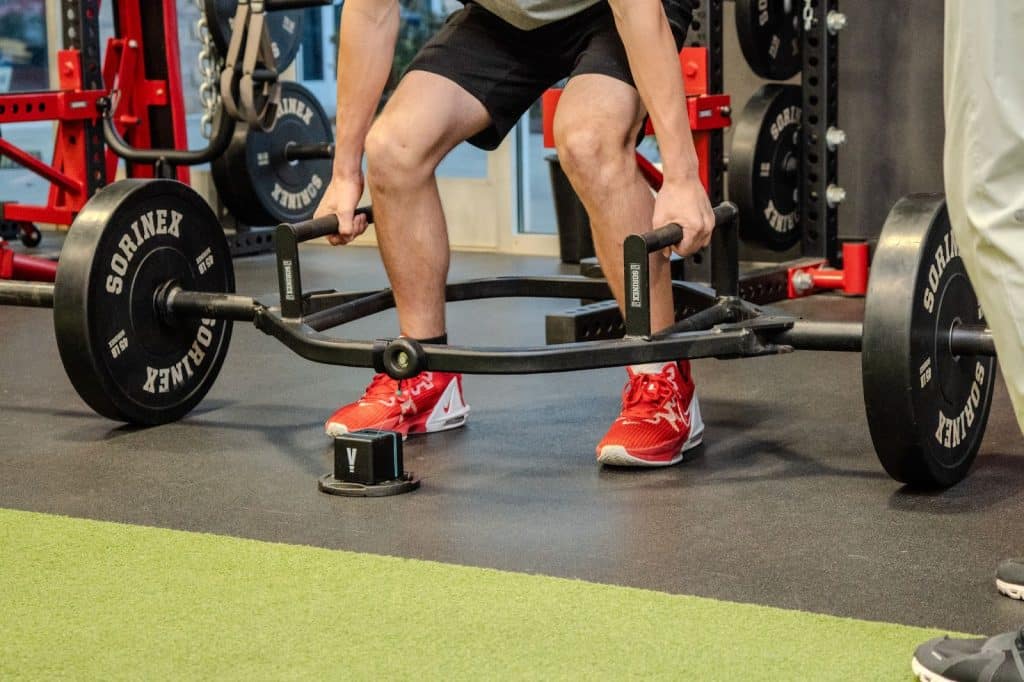
Camera-Based Systems
These systems use video cameras and software to track and analyze movements. They are non-invasive, providing a visual representation of the exercise along with velocity data.
- How It Works: Cameras record the movement, and software algorithms analyze the video to extract velocity and other movement data.
- Common Uses: Suitable for environments where non-contact measurements are preferred, such as team sports training facilities.
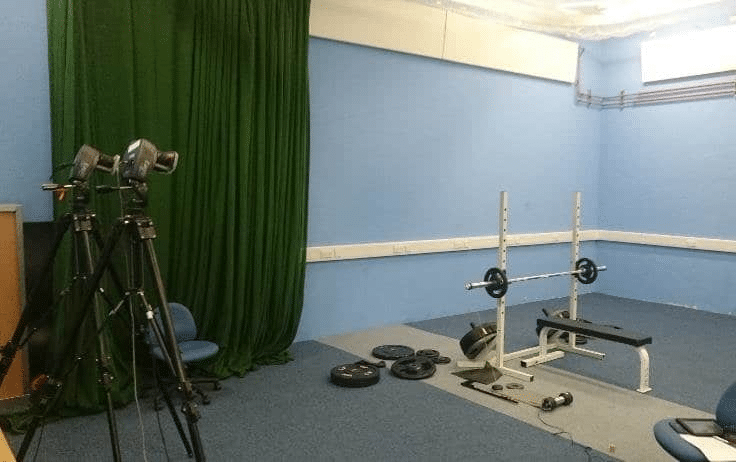
Accelerometers
Accelerometers are wearable sensors that track the rate of change in velocity. They are lightweight and versatile, making them a popular choice for various training types.
- How It Works: Sensors detect changes in velocity and provide data on acceleration, which can be used to infer velocity and force.
- Common Uses: Ideal for functional training, rehabilitation, and sports where versatility and portability are needed.
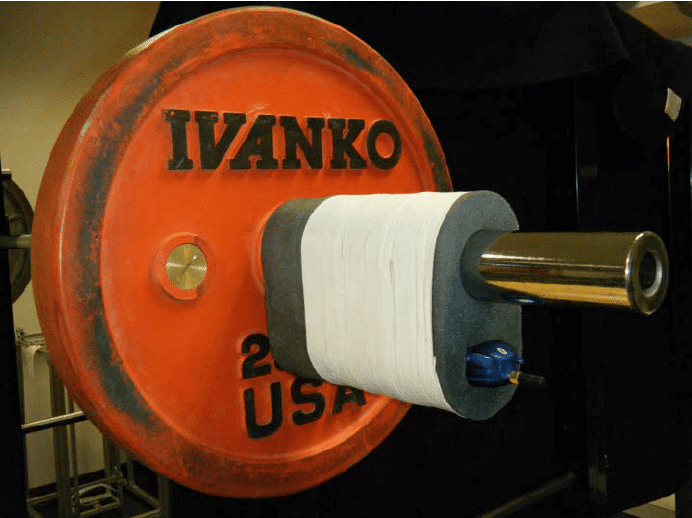
Inertial Measurement Units (IMUs)
IMUs combine accelerometers, gyroscopes, and magnetometers to offer a comprehensive analysis of movement. They provide detailed data on velocity, acceleration, and rotational movement.
- How It Works: By combining multiple sensors, IMUs capture detailed motion data, providing insights into complex movements.
- Common Uses: Used in advanced training scenarios, including sports science research and high-performance athletics
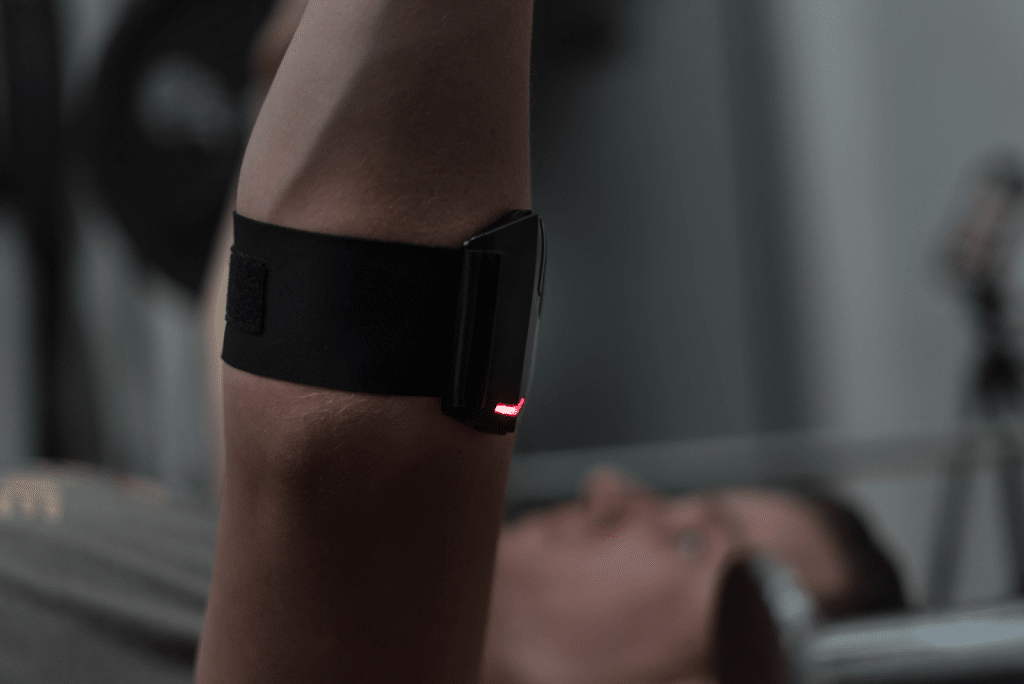

Velocity Based Training 【 #1 VBT Guide in the World 】
What is the accuracy of a VBT device?
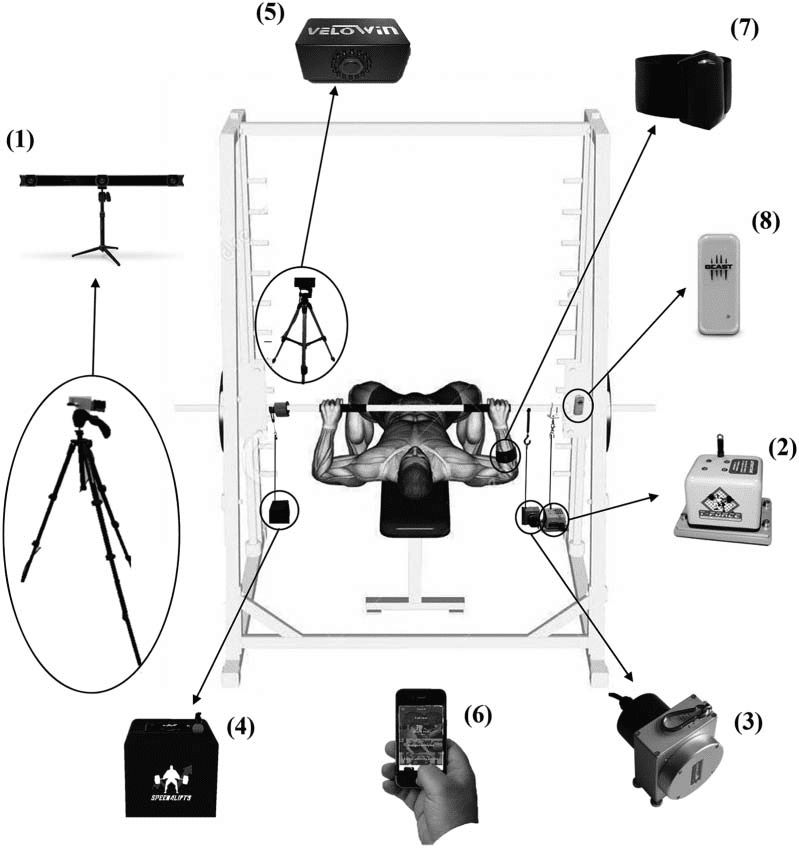
There is a research published in The Journal of Strength and Conditioning Research which evaluated the reliability and validity of these seven popular VBT devices in te market.
- Trio-OptiTrack: optical motion detection system.
- T-Force: linear speed transducer.
- Chronojump: linear position transducer.
- Speed4lits/Vitruve: linear position transducer.
- Velowin: optoelectronic sensor based on a camera.
- PowerLift (now called My Lift): Smartphone application.
- Push band: inertial measuring accelerometer.
- Beast sensor: inertial measurement accelerometer.
This study compared the reliability and concurrent validity of 7 commercially available devices for the measurement of movement velocity during the bench press exercise performed in a Smith machine.
The results of this study speak in favor of the Speed4Lift (now called Vitruve) as the most reliable and valid device for the measurement of movement velocity during the bench press exercise performed in a Smith machine.
Advantages and Disadvantages of VBT Devices
Understanding the strengths and weaknesses of each device type is crucial for making an informed decision.
Linear Position Transducers (LPT)
✔︎ LPT advantages
- High precision in velocity measurement.
- Real-time feedback suitable for immediate training adjustments.
- Reliable data for strength and power training.
✖︎ LPT disadvantages
- Requires physical attachment, limiting movement.
- Primarily useful for barbell exercises.
Linear position/velocity transducers have been routinely used for training and testing purposes (5,16,29). These devices have been considered the “gold-standard” to measure barbell velocity in many studies (2,3,5).
Camera-Based Systems
✔︎ Advantages of Camera-Based Systems
- Non-invasive, allowing free movement.
- Provides additional insights through video analysis.
- Can be used for a variety of exercises.
✖︎ Disadvantages of Camera-Based Systems
- Dependent on camera quality and environmental conditions.
- Potential for accuracy issues if setup is not ideal.
- Higher cost due to the need for high-quality cameras and software.
- There is no research that validates the accuracy of camera-based systems.
Accelerometers
✔︎ Accelerometers advantages
- Easy to use and portable.
- Suitable for a wide range of movements.
- Affordable and widely available.
✖︎ Accelerometers disadvantages
- May lack the precision of LPTs.
- Susceptible to noise and drift, affecting accuracy.
- Limited to measuring acceleration, not direct velocity.
Inertial Measurement Units (IMUs)
✔︎ IMUs advantages
- Comprehensive data on movement, including rotation and acceleration.
- Highly versatile, suitable for various sports and training environments.
- Advanced analytics capabilities.
✖︎ IMUs disadvantages
- More complex setup and calibration required.
- Higher cost compared to simpler devices.
- Data interpretation may require expertise.
The 2 IMUs, especially the Beast sensor, showed the lowest concurrent validity (i.e., lower r coefficients and larger random errors) as compared to the Trio-OptiTrack system. The Speed4Lift was the only device that did not report heteroscedasticity of errors.
What to Consider When Choosing a VBT Device Solution
Choosing the right Velocity Based Training Device requires careful consideration of several factors:
- Budget: Determine how much you are willing to spend. VBT devices range from a few hundred to several thousand dollars.
- Training Environment: Consider where and how you will use the device. LPTs are suitable for gym settings with specific exercises, while accelerometers are more versatile for different environments.
- Accuracy Requirements: Precision is crucial for effective training. LPTs are known for their high accuracy, making them ideal for serious strength training. Camera-based systems and accelerometers offer good accuracy but may vary based on conditions.
- Ease of Use: Look for devices that are easy to set up and integrate into your training routine. Vitruve’s intuitive software and real-time feedback make it a user-friendly choice, especially for coaches managing multiple athletes.
- Data and Analytics: Evaluate the software capabilities of the device. Good VBT systems offer comprehensive data analysis, tracking progress over time, and integrating with other training tools. Brands like Vitruve excel in providing robust analytics.
- Portability: If you need to move the device frequently or use it in different locations, consider portable options like small and portable LPT devices, accelerometers and IMUs.

Best Velocity Based Training Devices Brands of 2025
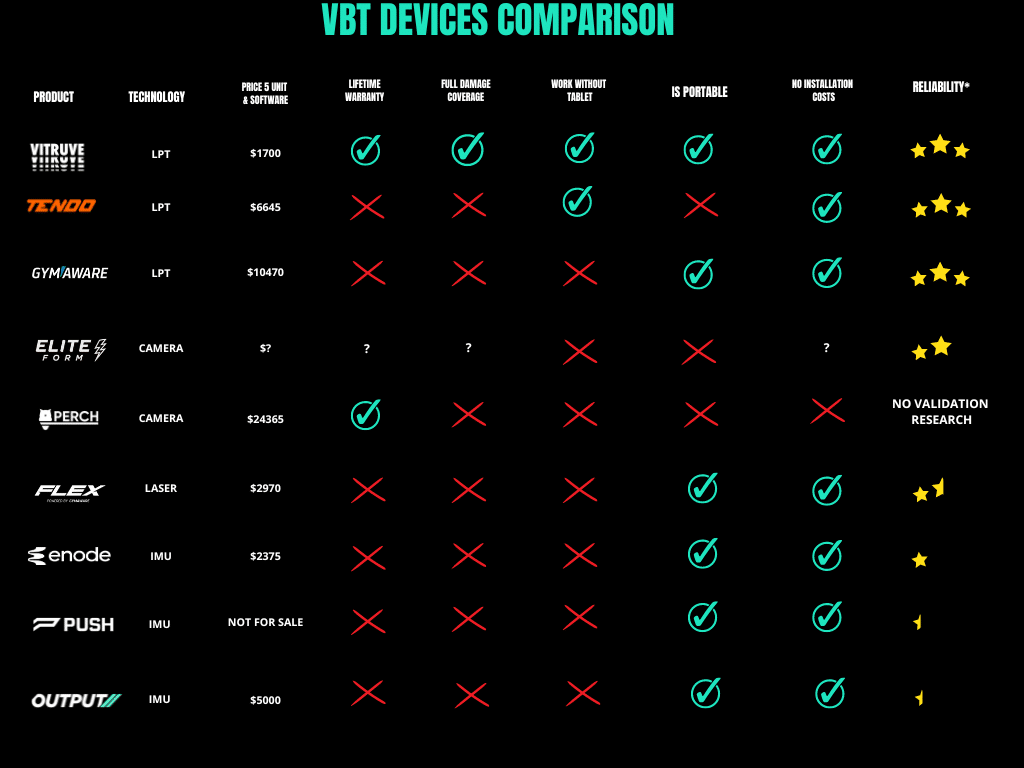
Several brands offer Velocity Based Training devices, each with unique features, price points, and advantages. Here’s a look at some of the leading brands of the market, including Vitruve, and why Vitruve stands out.
1. Vitruve
- Technology: Linear Position Transducer (LPT)
- Description: Vitruve offers a reliable and accurate LPT device, ideal for coaches and athletes looking for high precision in velocity measurements. It is designed to be affordable while delivering professional-grade accuracy.
- Cost: Encoder €447
- Features: Real-time feedback, intuitive software integration, high accuracy, affordability.
- Why Vitruve is the Best: Vitruve provides the perfect balance between cost and accuracy, making it accessible to a broader range of users while maintaining high standards of measurement precision.
2. GymAware
- Technology: Linear Position Transducer (LPT)
- Description: A premium LPT device known for its accuracy and reliability, widely used by professional sports teams and research institutions.
- Cost: Around $2,000
- Features: High precision, robust software, cloud-based analytics, integration with other performance tools.
3. Perch
- Technology: Camera-Based System
- Description: A non-contact VBT solution that uses cameras to track barbell movement, providing velocity data and video feedback.
- Cost: Around $2,500
- Features: Non-invasive, visual feedback, easy setup on power racks, data synchronization.
4. Vmaxpro
- Technology: Inertial Measurement Unit (IMU)
- Description: Vmaxpro combines accelerometers and gyroscopes to deliver comprehensive movement analysis, suitable for various sports and training environments.
- Cost: Approximately $450
- Features: Detailed motion data, wearable, versatile, robust analytics software.
Scientific Validations for the use of VBT Devices
Scientific research supports the use of Velocity Based Training devices for improving athletic performance. Several studies highlight the benefits of using VBT technology:
- Accuracy and Precision: Research consistently shows that LPTs, like those used by Vitruve, provide accurate velocity measurements crucial for optimizing training loads and ensuring safe progression.
- Effectiveness in Performance Enhancement: Studies demonstrate that athletes using VBT devices can fine-tune their training intensity more precisely than traditional methods, leading to improved strength, power, and speed.
- Reduced Risk of Overtraining: By monitoring velocity, coaches can detect signs of fatigue and adjust training loads accordingly, preventing overtraining and reducing injury risk.
- Enhanced Athlete Engagement: Real-time feedback provided by VBT devices enhances athlete motivation and engagement. Knowing their performance is being tracked and analyzed encourages athletes to push their limits.
- Versatility Across Sports: VBT devices are used in various sports, from weightlifting to team sports like soccer and basketball. The ability to provide instant feedback makes them valuable for diverse training needs.
Based on the comparison of the median CVs of the 5 loads, the devices were ranked from the most to the least reliable as follows: (a) Speed4Lift (CV = 2.61%); (b) Velowin (CV = 3.99%), PowerLift (3.97%), Trio-OptiTrack (CV = 4.04%), T-Force (CV = 4.35%), and Chronojump (CV = 4.53%); (c) PUSH band (CV = 9.34%); and (d) Beast sensor (CV = 35.0%).
*Speed4Lift changed their brand to Vitruve

In Conclusion
In conclusion, choosing the right VBT device can significantly impact training quality and outcomes. With various options available, from the affordability and precision of Vitruve VBT Device to the advanced analytics and the versatility of wearable devices, understanding your specific needs is essential.
Vitruve stands out as the best choice for those seeking a balance between cost, accuracy, and ease of use. Its affordable price point, combined with high precision and intuitive software, makes it an excellent option for coaches and athletes aiming to integrate VBT into their training routines effectively. By considering factors such as budget, training environment, accuracy, and scientific validations, coaches and athletes can make informed decisions to enhance performance and achieve their goals.
